
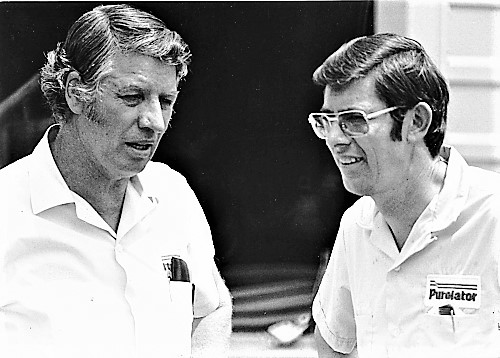
Glenn and Leonard Wood
GLENN WOOD - 7/18/1925 - 1/18/2019
LEONARD WOOD - 9/22/1934 -
WOOD BROTHERS – is an American auto racing team that competes in the NASCAR Cup Series. The team was formed in 1950 by Glen and Leonard Wood, hence the "Wood Brothers". The Wood Brothers merged with Tad and Jodi Geschickter's JTG Racing in 2006 to increase their competitiveness and bring about sponsorship but separated for the 2008 season. The Wood Brothers Racing Team holds the unique distinction of being the oldest active team in NASCAR, having fielded cars since 1950. They are known for their long relationship with Ford Motor Company, and the long standing use of number 21 on their main car. The Wood Brothers Racing Team was formed in 1950 by brothers from the Blue Ridge Mountains of Southwest Virginia. The boys had a talent for auto mechanics and
spent much time at their father's garage; with each brother serving as a mechanic, they formed a stock car racing team. Curtis Turner, a local sawmill operator from nearby Floyd, Virginia, inspired them. Coincidentally, Turner would later drive for the Wood Brothers. In the early 1950s, none of the Wood boys wanted to drive. Then they got fellow lumberman, Chris Williams, as their driver. In the early days of stock car racing, teams drove their cars to the track, raced them, and drove them home. Williams and the Wood Brothers bought their first car for $50. Chris Williams and Glen Wood each drove a few races. They became successful, winning races at Bowman Gray Stadium in Winston-Salem, NC, and Martinsville Speedway in Martinsville, Virginia. Shortly after their early success, Chris Williams sold his share of the team to Glen Wood to focus on his lumber business. Over the early years the
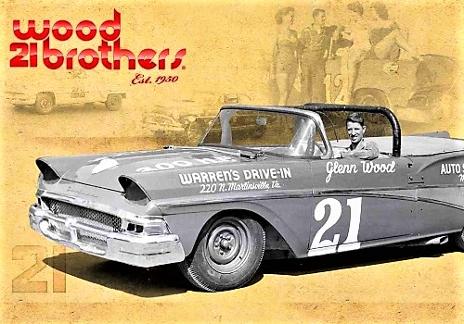
Glenn Wood Convertible Series
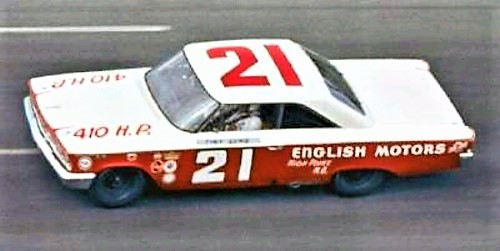
Tiny Lund - 1963 Daytona 500 win
Wood Brothers years, the Woods Brothers Racing Team evolved from a weekend hobby into a full-time business. Glen and Leonard worked full-time building and preparing cars, while the other brothers and crew worked nights and weekends apart from their regular jobs. Their first permanent racing shop was at the town limits of Stuart, Va. The team adopted the #21 permanently and would become as notorious as any number in NASCAR history. The Wood Brothers also found themselves lured to the big-ticket cash prizes offered by the growing super speedway races in cities such as Daytona, Fla.; Charlotte, NC ; and
Darlington, SC. Glen Wood soon stepped out from behind the wheel of the No. 21 Ford, and they began hiring drivers with reputations as winners at the different tracks. Speedy Thompson got the Wood Brothers their first win (other than with Glen wood driving) as he pulled off a win at Charlotte Speedway beating Richard Petty by over a lap. Thompson raced for the Woods three times that season; won twice and finished fourth the other event. Marvin Panch was the first 'name' driver to drive their cars on a regular basis. In 1965 Panch would run 20 of that seasons 55 races and win four times. He'd post 14 Top 10 finishes and finish fifth in the points. The first time the team would crack the Top 5. The team soon began competing on the
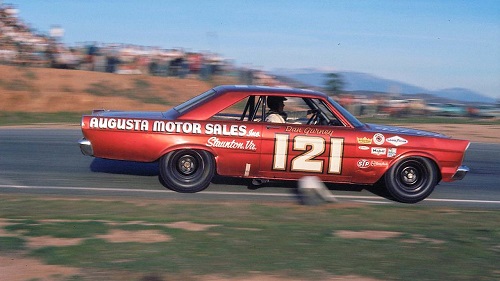
Dan Gurney multiple Riverside wins

Wood Brothers pitting Indy 500 winner Jim Clark
highest levels of the sport. Victories were won with the mechanical genius of the team of brothers, relatives, and friends. Leonard Wood's talent in the engine department soon brought the team acclaim and was second in the early years only to the fabled Holman-Moody engine juggernaut and the Petty racing dynasty of Lee Petty and son Richard Petty. The Wood Brothers invented the modern pit stop. In the early days of all types of motor racing, when service was needed during the race it was common for drivers to pull into the pits, turn off the car, get out and even smoke a cigarette as the crew took their time changing tires and servicing the cars. The Wood Brothers recognized that by limiting the time off the track, it could increase their position on the track. Thus they created and perfected what is now known as the pit stop. It is as common to all
types of racing as the checkered flag itself. Other racing organizations noticed the pit stop innovations of the Wood Brothers. Also In 1965, the Wood Brothers team was hired to act as the Lotus-Ford pit crew at the Indianapolis 500, a race won by the Lotus-Ford of Jim Clark. With the Indy 500 win, the Wood Brothers Racing Team began to enjoy international acclaim as pioneers and leaders in motor sports. The Wood Brothers signed a long-term sponsorship agreement with Purolator to be their primary sponsor on the No. 21 car. Their drivers prior to and during this era had included a "Who's Who" of the best in stock car racing. Among those driving for the Wood team through
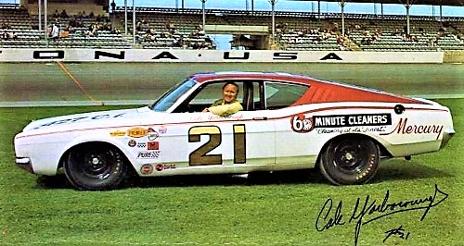
Cale Yarborough - 1968 Daytona 500 winner
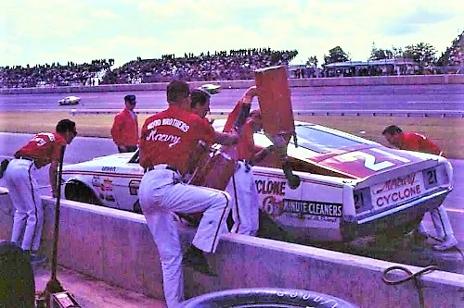
the mid-1960s were Curtis Turner, Marvin Panch, Fireball Roberts, Parnelli Jones, Tiny Lund, Junior Johnson, Speedy Thompson, Fred Lorenzen, and Cale Yarborough. In those years, the Wood Brothers also entered a second car, No. 121, in select events. Open-wheel star Dan Gurney, who enjoyed popular victories in Indy and Formula One racing, was hired by the Wood Brothers to drive in the No. 121 at road course events. The Gurney-Wood combination proved unbeatable, and they dominated the early road courses on the NASCAR circuit by winning every race in which Gurney drove for the Woods. This streak included the Motor Trend 500 at Riverside, California, in which Gurney won with the Wood's # 121 in 1964, 1965, 1966 and 1968. The Wood Brothers hired Cale Yarborough to drive for the from 1967 - 1970. Still only running part time, Yarborough won six of
20 races in 1968, and he added a total of seven wins the other three seasons. In the early 1970's, the Wood Brothers continued their success. The lightning-quick pit stops and high-powered engines of the No. 21 car proved a formidable challenge to all on the NASCAR circuit. Legendary drivers such as Donnie Allison and open-wheel Indy 500 winner A.J. Foyt also took turns piloting the Wood car. Glen Wood emerged as the leader and patriarch of the team. Glen's young sons Eddie Wood and Len Wood also began working at the shop in menial labor jobs. Brother Delano Wood had evolved into one of the greatest pit crew
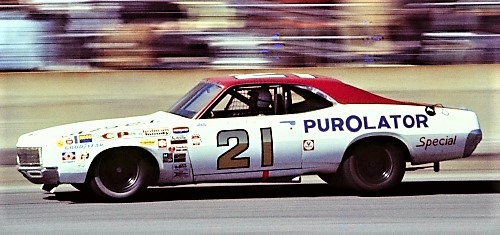
AJ Foyt - 1972 Daytona 500 winner

David Pearson - 1976 Daytona 500 winner
members, and his skill as a jack man is incomparable even today. In 1972, David Pearson s hired to be the full-time driver of the #21. This choice would pave the way for one of the most successful strings of victories in motor sports history. Pearson would continue to drive the car from 1972 through 1979. In only seven years, the team entered 143 races and amassed a staggering 46 victories and 51 pole positions. In 1973 Pearson entered only 18 events and won 11 times. In 1976, with Pearson behind the wheel, the Wood Brothers won the coveted "Triple-Crown" of NASCAR racing. This feat was accomplished by winning the legendary Daytona 500 at Daytona International Speedway; plus the World 600 at Charlotte Motor
Speedway; and the Southern 500 at Darlington Raceway. All of this was accomplished during the 1976 season while he only ran 22 races and visited victory circle 10 times. In 1979 Pearson started out the season with the woods; but parted ways with the team after only five races, and was replaced by an emerging talent named Neil Bonnett. He would run 17 races where he would win three times. Bonnett and the Wood team had a successful relationship, but lasted only three and a half seasons and 83 races; but Bonnett would win eight times. During the "Bonnett Years," the Wood Brothers long term sponsorship by Purolator would come to an end (mid-season 1981), marking one of the most enduring and synonymous sponsorships in the history of NASCAR. The #21 was then

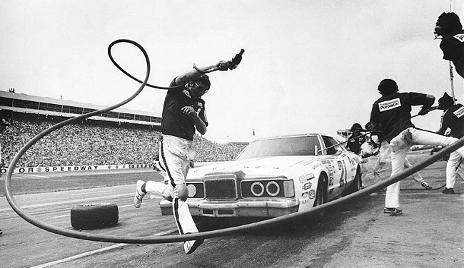
sponsored by a company called National Engineer that was owned by the flamboyant Warner Hodgdon, who proudly had his name placed on the No. 21 as the primary sponsor. The Hodgdon sponsorship was believed to have been one of the richest deals of its time in NASCAR racing. In the mid-1980s NASCAR entered what is now called the modern era of the sport. This period also marked the first-ever quest for points championships by most teams. Since the 1950s many teams had run only select races. Now however, in order to compete for the series title and its large cash prize, teams would be required to compete in all events in a scheduled season. The Wood Brothers decided to make the leap to running a full-time schedule.
This new commitment also saw the departure of Neil Bonnett and he took the Warner Hodgdon and National Engineering sponsorship with him. The Wood Brothers brought Valvoline on board as their chief patron. In 1983, legendary driver Buddy Baker was hired to a departing Neil Bonnett in the #21 car. Baker and the Woods struggled for the first time in many years, with Baker only winning once. The pairing only lasted two seasons together. In 1985 history was made in NASCAR as a young Kyle Petty, the grandson of legendary Lee Petty and son of series-dominator Richard Petty, was hired to drive the Wood car full-time. This formed a unique union between the two most successful racing families in NASCAR history. This also marked the addition of a new sponsor to the Wood Brothers team. A trio of corporate sponsors consisting of 7-Eleven, Citgo, and Chief AutoParts were brought on board with the Wood Brothers and Petty for the 1985 season. As part of their marketing strategy, the Wood Brothers were required to relinquish their world-
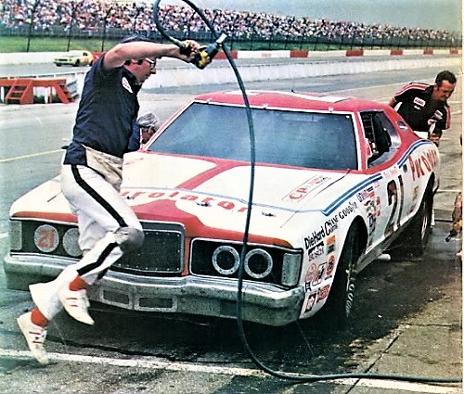
1979 pit action

Neil Bonnett 1982
famous #21 car number and adopt the #7 in favor of 7-Eleven's brand sponsorship. This period also marked the emergence of the second generation of Wood Brothers, Eddie and Len, who had increased their responsibilities with the team over the years. They were now effectively calling the shots on race day for the team, and an "anything goes" attitude was welcomed within the team. With Kyle Petty in the seat, the Wood Brothers Ford would find victory in their second season together, 1986, at Richmond International Raceway in Richmond, Virginia. The next year, 1987, the team won the Coca-Cola 600 at Charlotte Motor Speedway. Just as the Petty-Wood relationship was beginning to bear fruit, Kyle Petty found himself lured to a new team, SABCO Racing, owned by the wealthy Felix Sabates. Unable to refuse the lucrative offer, Petty left the Wood Brothers after four seasons and 115
races together and two wins. The Wood Brothers switched back to the legendary #21 which had been synonymous with the Woods since their early days. This was effected partially due to the loss of 7-Eleven as their primary sponsor, and the elevation of Citgo Petroleum from secondary to primary sponsorship placement with the team. Bonnett returned to the Wood Brothers in 1989. By 1990, the Wood Brothers were back in the #21 Ford with Citgo as a sponsor. But their promising season took a big blow at the season's fifth race. Neil Bonnett crashed heavily and it would virtually end his career. His good friend Dale Earnhardt Sr would talk him to return to Cup racing and he would run two races in 1993. Tragically Bonnett was killed in practice for the Daytona 500 in 1994. The early season loss of Neil Bonnett required a
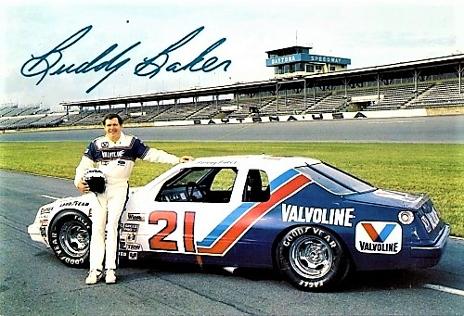
Buddy Baker 1984
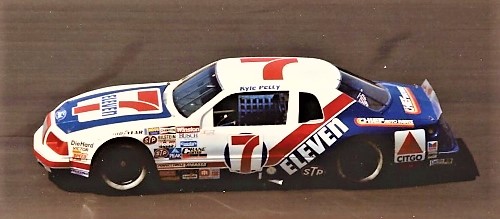
Kyle Petty 1985 World 600 winner
replacement driver. Eddie and Len Wood turned to old-time friend Dale Jarrett to take his rightful shot at the Winston Cup Series. Dale Jarrett was the son of former NASCAR champion and broadcaster Ned Jarrett, and had grown up in the sport with the Wood boys. The choice of Jarrett would prove brilliant. In their first full season together in 1991, Dale Jarrett would bring the Wood Brothers #21 to victory at Michigan, narrowly edging out Davey Allison by inches in one of the closest wins in NASCAR history. The Michigan victory supported a unique
record for the Wood team. Every single rookie driver who had ever driven for them for at least a full season had scored at least one victory in the Wood car. More impressive was the fact that every driver to have driven for the Wood Brothers for a full season from 1953-2002 had won at least one race behind their wheel. The Wood-Jarrett combination was widely considered to be as bright a future as any team in NASCAR's future; however, Jarrett was soon lured away by Washington Redskins coach Joe Gibbs who formed a new team with the finances to entice Jarrett to leave the #21. This new ride would earn Jarrett his first Daytona 500 win with Gibbs. With Jarrett's departure, the Woods sought out the veteran Morgan Shepherd to fill the seat in the 1992 season. Shepherd had been a solid, dependable finisher in the top series for most
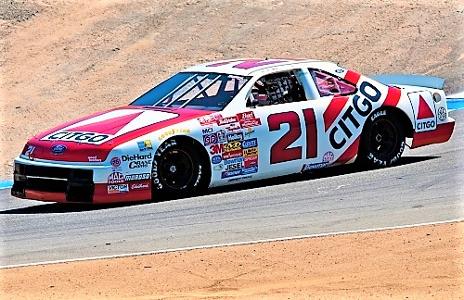
Dale Jarrett 1990
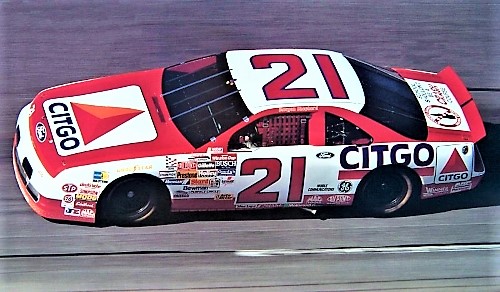
Morgan Shepherd 1993
of his career and was a serious championship contender. With his consistent top finishes, Shepherd would provide strength as the team continued to adapt to the growing sport. Morgan Shepherd would do very well with the #21 Citgo team, and would provide consistent finishes in all four seasons he ran for the Wood Brothers. Their one and only victory came at Atlanta Motor Speedway in March 1993, a race that was delayed six days because of a snow storm in the Atlanta area the previous weekend, and provided a much-needed boost for the team who had suffered a drought since Jarrett's victory at Michigan. With the 1996 season upon them, the Woods sought a younger driver to fill the seat of the #21 Ford. As Shepherd was
approaching retirement age (HAHAHA Reaching retirement age..?? Shepherd didn't retire from Cup until the end of the 2014 season at the age of 73; and didn't retire from the Xfinity series until after 2019.), and a youth trend had risen with hot drivers like Jeff Gordon, the team was looking to ride a similar wave. They parted ways with Shepherd and welcomed Michael Waltrip, the younger brother of three-time series champion and legend Darrell Waltrip. But the marriage would prove fruitless, as Waltrip failed to win a race in the three season he spent with the team; and only posted one Top 5 finish. With the dawn of the 1999 season, the Wood Brothers brought in Elliott Sadler to replace a departing Michael Waltrip. Like the

Michael Waltrip 1994

Elliott Sadler 2001 Bristol win
Woods, Sadler was a Virginia native whose family had been involved in racing for many years. Sadler represented a young, talented Rookie looking to make a name for himself in the Cup Series. Young Elliott Sadler cut his teeth in the #21 car, and was soon performing on par with the best in the top NASCAR circuit. Eddie and Len had brought in Crew Chief Mike Beam, marking a historic first time that someone outside the Wood family had served as crew chief for the #21 team. Bean had seen success with Junior Johnson, Bud Moore, and others prior to arriving at the Woods. On the track, the Sadler-Wood combination began to bear fruit in the 2001 season, with Sadler capturing his first victory in the #21 Ford at Bristol Motor Speedway in Bristol, Tennessee. This win, oddly, was the first win for the Wood Brothers in their career at Bristol. Elliott Sadler continued to improve with the #21 and his evolution was quickly making him a target for other teams. Therefore, it was not a surprise when Sadler was lured away to Robert Yates Racing with another lucrative career move. The Sadler period for the Wood team had lasted 139 races, which was the longest single stretch for a pilot
of the #21 since David Pearson drove in the Wood's heyday. Sadler's departure would signal the end of the "win streak" which saw every full-season driver of the Wood car win at least one victory since 1953. Elliott Sadler was replaced by veteran winner Ricky Rudd, another Virginia native. Eddie and Len Wood continued to seek the right mix of crew members and chemistry, shuffling through personnel and crew chiefs to finally hire Michael "Fatback" McSwain as Crew Chief of the #21 Motorcraft Ford. McSwain and Rudd had worked together while at Robert Yates Racing several years prior. Ricky Rudd and the Wood Brothers enjoyed a successful run in 2004, again
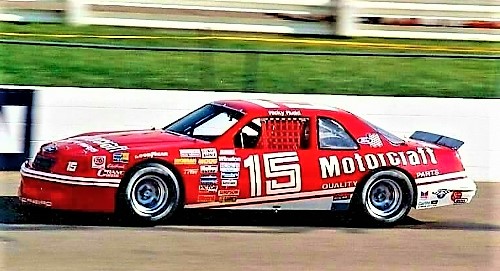
Ricky Rudd 2003
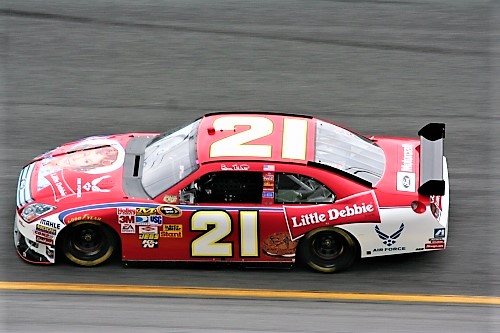
Bill Elliott 2008
nearly winning and taking home a second place finish. They also won a pole position, the team's first since 1984 with Buddy Baker in the #21. The 2005 season saw another second place finish for Rudd in the #21 at California. At the end of the 2005 season, Ricky Rudd announced his retirement. He stepped down after only three seasons with the Wood Brothers during a period of tremendous change for the team. The Woods announced that veteran driver Ken Schrader would drive the No. 21 in 2006. Among the changes to the No. 21 team was the elevation of Michael “Fatback” McSwain from crew chief to manager of racing operations for the team. The crew chief hired for the 2006 campaign was David Hyder, who worked with Schrader at BAM Racing. In 2007 Ken Schrader & Bill Elliott split driving the #21 car and the Wood Brothers cut
back to just racing part time. In 2008, Bill Elliott, Marcos Ambrose, and Jon Wood shared driving responsibilities of the #21. Ambrose had a best finish of 3rd at Watkins Glen, but left the team halfway through the season. In 2009, the Wood Brothers again ran a partial schedule, competing in only 13 races. The season included four Top-10 qualifying efforts, including a season best fourth at Indianapolis. The Motorcraft Ford Fusion driven by Bill Elliott also four top 16 finishes. 2010 returned the Wood Brothers to the race track as they celebrated 60 years in NASCAR. They returned to Daytona in February looking for their fifth Daytona 500 victory with Bill Elliott behind the wheel of the Motorcraft Ford Fusion; Elliott ran a competitive race, but got caught up in an accident with a lap to go. NASCAR had instituted their policy of races not

Ken Schrader 2008
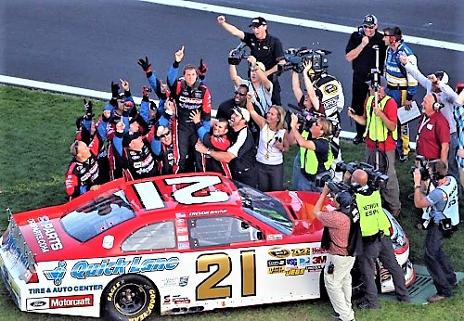
Trevor Bayne Daytona 500 win 2011
finishing under yellow, so it went 208 laps total. Elliott's damage to his car left him on the lead lap, but finished 27th. During the span from 2007-2010 the Wood Brothers struggled mightily. They only posted one Top 10 finish; a third by Ambrose. In 2011, Trevor Bayne became the youngest driver in Wood Brothers history, taking over duties of piloting the #21 in at least 17 races; including the first 5 races of the season. On February 20, one day after his 20th birthday, Trevor Bayne won the 2011 Daytona 500. It was the first win for Wood Brothers Racing since Elliott Sadler at Bristol during the 2001 season. However it would be Bayne's only Top 10 finish for the year. Bayne returned in 2012 - 2014, but they still ran less than half of the races each year. During that span Bayne could only post two Top 10 finishes. Ryan Blaney replaced Bayne in 2015 and the Rookie showed some promise. In the 16
races that he ran; he had one Top 5 and two Top 10 finishes. It was the best results the Wood Brothers had posted since 2005. The Wood Brothers joined forces with Roush Fenway Racing to get technical support from them; and for the first time in nine years ran a full schedule. 2016 saw Blaney show that he could run well in a competitive car. He had three Top 5 and nine Top 10 results. The following season Blaney ran up front a lot; and at Kansas he would out duel Brad Keselowski to give the wood Brothers their first win since 2011. For 2018,

Ryan Blaney 2017
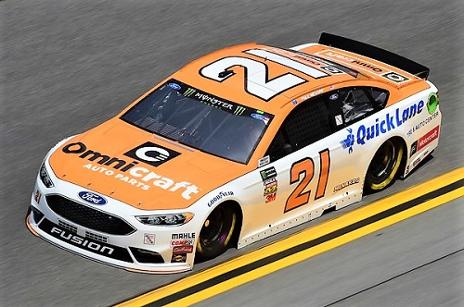
Paul Menard Daytona 500 2018
Blaney was hired away from the Woods and Paul Menard drove the famous #21 this season, looking to get the Woods Brother 100th win. Menard didn't have a lot of success as he only posted a best finish of fifth at Michigan. He did have seven top ten finishes and only finished 19th in points. Paul Menard returned to wheel the famous #21 Wood Brothers Ford in 2019. Unfortunately the results wasn't much different than the previous year. It's just tough for a single car operation to run up front with the multi-car organizations. Paul only managed a best finish of sixth at Bristol for one of only four Top 10's all season. Most of Menards runs all seemed to fall into the "teens" finish range. Although he only had four top tens; he had 14 top 15 finishes and 28 top 20's That wasn't good enough to get into the Chase. Menard announced a couple
months before the end of the season that he was going to retire from full time NASCAR racing to spend more time with his family. Matt DiBenedetto was let go by Levine Family Racing at season's end, and Menard lobbied the Wood Brothers to hire him to take his place in 2020. The Woods agree that would be a good plan, so DiBenedetto drove the Wood Brothers machine in 2020 looking for win #100. In Las Vegas, the second race of the season he almost did so. He finished second just getting beat by Joey Logano. When NASCAR returned to Las Vegas in the Fall, he once again finished second, this time right behind Kurt
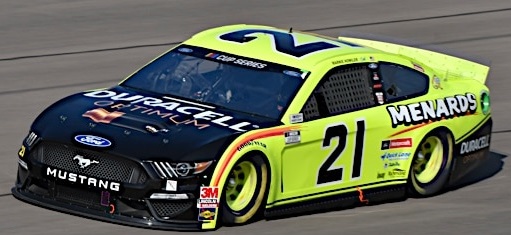
Matt DiBenedetto Las Vegas 2020
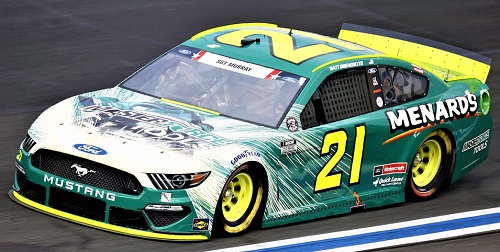
Matt DiBenedetto 2021 Coke 600 Charlotte
Busch. Matt posted many finishes in the Top 10 and low teens. He made the Chase via points. The first time a Wood Brothers had been in the Chase since 2018. DiBenedetto had three Top 5 finishes and eleven Top 10. Towards the end of the season it was in question if DiBenedetto would be back with the Wood Brothers in 2021. Team Penske gives a lot of support to the Wood Brothers; and Austin Cindric was tearing up the track in the Xfinity Series. Austin is the son of Team Penske President Tim Cindric. Just before the season ended it was announced that DiBenedetto would remain with the Wood
Brothers for 2021; but Cindric would take over the ride in 2022. As it turned Austin Cindric would go drive the #2 car for Team Penske when Brad Keselowski decided to leave and be part owner in Roush racing and be an owner/driver. Now Harrison Burton will be brough in to pilot the #21 car. In 2021, DiBenedetto seemed to have a season of ‘streaks. It started off with him knowing he was out of a ride at the end of the year. It got off to a slow start with finishes 28th or worse the first three races. Then at Phoenix he finished 14th. The next three races he finished between 11th and 13th; then things got better as he run off a string of Top 10 finishes; with two of them being Top 5’s. Then his luck changed and he had no finish
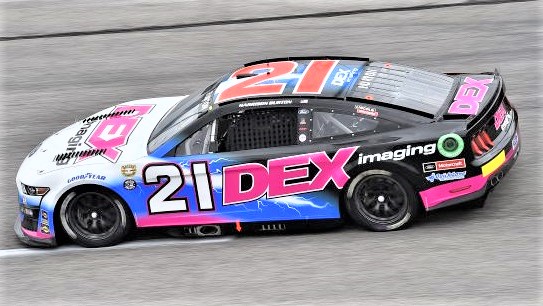
Harrison Burton 2022 Cup ride

Glenn (left) and Leonard Wood
better than 18th over a eight race span. Then his luck changed again where he would finish no worse then 11th for six races. Then the rest of the season he would only have two races where he finished in the Top 10. As the season closed; he had no idea of if he would have a ride in the Cup Series; or any series. It appears all of the Cup rides are taken with new teams coming into NASCAR and bringing their own drivers along. In 2022, the Wood Brothers were back in the Cup series for an incredible 69th year. Harrison Burton had moved from the Xfinity Series up to drive for the Woods in search of their 100th win. They have been winless ever since 2017 when Ryan Blaney got win #99. Burton started off the season looking strong in the Daytona 500. He was leading coming off turn two when he got loose and then got run into from behind; sending him into a flip. His car was damaged, but he was OK, finishing 39th. It took until race #19 at Atlanta until Burton would claim his first top ten. At the road course of Indy; Burton had a great run and finished third; his only top five of the year. He only posted 14 top 20's on the year. Burton's contract is year-to-year, but he was back in 2023. The Wood Brothers hold many records and historic achievements. Among these are the fact that they have fielded only Ford Motor Company products since 1950, which makes the longest association
of any motor sports team with a single manufacturer ever. The Wood Brothers also have won at least one race in every decade for the last six decades, an unmatched feat. They have 99 total victories, and remain among the winningest racing teams in the history of NASCAR racing for 64 years. Major wins the team have achieved include: five Daytona 500's (1963, 1968, 1972, 1976, & 2011 ); four Southern 500's (1968, 1976, 1977, & 1981); and three World 600's (1974, 1976, 1982, & 1987). Both of the Wood Brothers have been inducted into the NASCAR Hall of Fame. Glenn (on left) was inducted in 2012, and his brother Leonard (on right) was inducted in 2013.
All Photos copyright and are property of their respective owners
